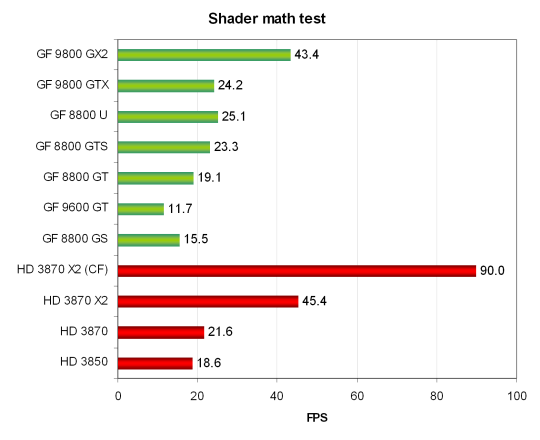Feature Test 5: GPU Particles
Physics simulation test based on particle systems computed with the help of GPUs. The test also uses vertex simulation, where each vertex is a single particle. Stream out is used for the same purpose as in the previous test. The test computes hundreds of thousands of particles, all of them being animated separately, and their collisions with a bump map. Similar to one of our tests in RightMark3D 2.0, particles are drawn with a geometry shader, which creates four vertices from each point and forms a particle from them. However, the heaviest load falls on shader units (vertex calculations), stream out is used as well.

Practically the same story here - NVIDIA cards line up almost perfectly here, only GeForce 8800 GS with its lowest memory bandwidth and fill rate and the 8800 Ultra with the highest results fall out of line. The 9800 GX2 performs like its single-GPU counterpart. What concerns CrossFire, the dual-GPU system has almost no performance gains, but the quad-GPU system is more than four times as fast. That's not funny.
So we don't understand what the last two test measure. Fill rate or stream out performance. Although these results agree with some of our Direct3D tests in RightMark 2.0. We'll try to sort it out in the second part of the article.
Feature Test 6: Perlin Noise
This feature test is arithmetically intensive for a GPU. It calculates several octaves of Perlin noise in a pixel shader. Each color channel uses its own noise function for higher GPU loads. Perlin noise is a standard algorithm, which is often used for procedural texturing, it's a mathematically complex procedure.
So, the last feature test shows arithmetic performance of GPUs. That's where AMD cards outperform their competitors from NVIDIA. Although they still cannot catch up with top single-GPU cards from the second company. We again see an interesting divisible performance gain in multi-GPU systems from AMD. But GeForce 9800 GX2 fails here - SLI efficiency is not very high this time.
The 9600 GT is arithmetically outperformed by the 8800 GS and especially HD 3850. Other NVIDIA cards perform strictly according to theoretical data, although the 8800 Ultra is still in the lead. It's a purely arithmetic test, so its results agree with our arithmetic tests in RightMark 2.0.
Conclusions
One the whole, this benchmark is quite good from the point of view of modern 3D graphics technologies. It uses many innovations: complex shaders of all three types, GPU-assisted physics simulation (cloth and water simulation, particle systems), support for multi-core CPUs and physics accelerators, very powerful post processing, instancing, stream out, advanced parallax mapping, etc.
In terms of content (scenes, models, textures), not all of these tests can get an A grade. All scenes and models contain many polygons, textures are of high resolutions, animations are technically well implemented, but from the artistic point of view, for example, the first test is questionable. It's not particularly good-looking, if you don't go into technical details. OK, CPU tests must be plain, but graphics tests are too primitive, especially the first one. For this budget...
The benchmark has high system requirements, because we cannot even imagine a weaker gaming computer. Especially as the test is apparently developed for future applications. It will serve at least for a couple of years. Even the next generation graphics cards (until DirectX 11) can be benchmarked with 3DMark Vantage. The new profile feature simplifies comparison of graphics systems of different levels. The apparently negative moment is severe limitations of the trial version.
The test shows adequate results in a massive shootout of graphics cards from both main GPU manufacturers. So it's certainly fit for graphics cards' performance tests. Some of its synthetic tests are actually semi-synthetic, as they depend on several factors, but they allow to test all main systems of Direct3D 10 cards. If we discard several issues, these test results agree with our synthetic D3D10 tests in RightMark 2.0.
And don't forget that a detailed description and analysis of 3DMark Vantage is coming. This article is being written now, and it will be published this month already.
Write a comment below. No registration needed!


